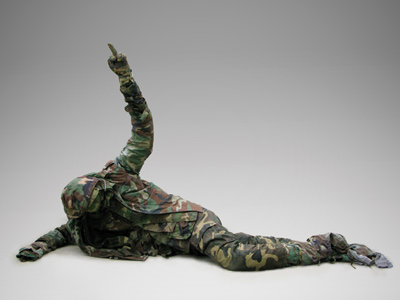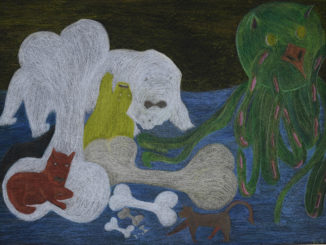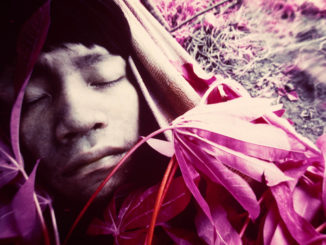 The artists Alain Guerra and Neraldo de la Paz, known as Guerra de la Paz, have been working as a collaborative unit since 1996. They reside and work in Miami, using the city as a launch pad for a life in art that has an ambitious scope above and beyond the local art milieu. Self-described “outsiders”, they make work scavenged from the material facts of this city. They are married to Miami in this sense, enjoying an intimate relationship of give and take with its jetsam and flotsam, harvesting its refuse, transforming its castoffs into work that is powerful and lyrical, formally challenging and deeply felt.
The artists Alain Guerra and Neraldo de la Paz, known as Guerra de la Paz, have been working as a collaborative unit since 1996. They reside and work in Miami, using the city as a launch pad for a life in art that has an ambitious scope above and beyond the local art milieu. Self-described “outsiders”, they make work scavenged from the material facts of this city. They are married to Miami in this sense, enjoying an intimate relationship of give and take with its jetsam and flotsam, harvesting its refuse, transforming its castoffs into work that is powerful and lyrical, formally challenging and deeply felt.
They are known for their “mounds”, great piles of garments layered in rainbow hues, like Tribute from 2002, which resemble exuberant piles of consumer excrement or ritual formations created by urban tribes of the homeless. “It’s garbage on its way to the landfills, ultimately becoming nature again,” says Neraldo. Their installations of overflowing garments attest to their oceanic range, while other installations are precisely sculpted to relate provocative or joyful narratives in polychrome tableaux vivant.
The collaborative is currently enjoying a very active period in their career, the result of seeking the bigger playing field – thinking globally, rather than locally – and the result of fruitful liaisons with fully operational support professionals. They insist “One of our main interests has been to show outside South Florida.” The same originality and self-determination that characterizes their aesthetic and technical evolution applies to their practical and business decisions.
“Our work is not easily accepted by established galleries.” Says Alain. “We were kind of like a long shot. Hooking up with someone starting out and willing to take a risk has made sense.” Neraldo and Alain emphasize that the relationship they enjoy with their agents is equally a friendship. “For us it’s important to work with anyone who believes in you and loves the work”, Neraldo added. But soon after their first New York solo show at Jack the Pelican gallery in Williamsburg in 2006, the collaborative started getting lot of attention. A featured interview in New York Arts magazine followed in 2007, making it to the magazine cover, and ever since, GDLP has jumped into a national and international ride that has rewarded their several years of commitment to their most deepest believe: Beauty can be uneasy.
During the last Art Basel Miami Beach week, their free-standing sculpture Nine was sold to the British giant Charles Saatchi. Essentially a mound held aloft by individuals, Nine has a strong counter-cultural connotation. It speaks of the triumph of the collective, of a variegated community working in unison, resisting powerful forces – like gravity. It’s ultimately celebratory. Saatchi’s collection, on the other hand, found its notoriety after producing and acquiring the controversial “Sensation” show in the early eighties that included works such as those produced by Damian Hirst and the Chapman Brothers. The collection has grown as to become one of the most polemic / acclaimed contemporary art collections in the world. By looking at GDLP latest productions, it is not difficult to establish the connection.
Their latest solo show was presented at Daneyal Mahmood Gallery in Chelsea, New York, in conjunction with Creative Thriftshop (CTS). Green Zone is a large landscape installation referencing the heavily guarded diplomatic area in central Baghdad where US personnel live and work. In the hands of the artists however – and in the center of New York City – the Green Zone turns into an artistic interpretation – that like in prior installations such as Overflow from 2002 or Oasis from 2006 – aims to one of the most current and controversial American conflicts.
The same installation will be featured as a special installation during Scope New York this March. Other exhibitions of note ahead are the 21C Museum Hotel in Louisville, Kentucky, the CIRCA Fair in Puerto Rico, and the John Michael Kohler Art Center in Sheboygan, Wisconsin. They’ll wrap up the year with residencies in Santander, Spain, and at the Elsewhere Artist Collaborative in Greensboro, NC.
But despite their globetrotting and a complex relationship with their chosen hometown, Guerra de la Paz is by no means invisible here in Miami. ArtCenter/South Florida premiered their work Nine in No Need to Touch exhibition in 2007, and more importantly, they will create an installation for the main branch of the Miami-Dade Public Library downtown in the Fall.
The intensity and momentum in the career of Guerra de la Paz reflects a growing complexity in their work. Both artists acknowledge that their compositions are becoming more involved and greater in size and scope. The humanism that propels them on a fundamental level has elicited a deeper realism in their figurative installations.
The camouflage series in particular has exposed a raw, more passionate set of emotions for their narrative, replacing some of the fantasy, childhood, and nature-oriented work in recent years. “It’s never been frivolous work,” comments Neraldo. Like Voodoo dolls or puppets, we are invited to project onto these figures our unresolved emotions and desires. “The garments aren’t even dry cleaned. It would strip them of their essence, sanitize them,” he emphasizes. Alain cites a return to classical and religious themes as an influence. In particular, the elongation of the figure, which has occurred in several pieces is inspired by El Greco’s work. Martyr from 2008, composed of layers of camouflage fatigues arranged to suggest a crucifixion, makes use of that dramatic elongation.
According to Alain, Green Zone describes a “perfect environment, peaceful, uninhibited, enchanted” disrupted by a horrific act or scenario which explodes that tranquility. The camouflage works recall effigy figures, paraded or publicly burned in protest. Emanating from these figures is a very powerful sense of soldiers martyred for dubious causes. Faceless, extremities lopped off, utterly devoid of robustness, the uniform is all that remains. “It’s all very personal,” confirms Neraldo.
“It’s a sign of the times, a subject that you address.” He points out that even the festive mounds can be perceived as symbols of oppression, associated with the macabre piles of victims’ belongings gathered at concentration camps during the Holocaust. By working with threatening imagery, they are creating art as an act of resistance. These works have a connection to early passion plays staged by the church in Europe, in which a familiar, instructive story of suffering is related through dramatic tableaux. Realism and protest are fused in recent painted works by Guerra de la Paz. Painting is performed as an additive, collaborative process by the two, just like their work with found objects. Their subject? A series of hands of friends and family members each giving the finger – the ultimate gesture of protest.
Unraveling the source of the devastation borne of war, Guerra de la Paz has turned to the corporate footsoldier in recent works. Nooses and snakes constructed out of “power ties” insinuate the treachery of “the deal”. The “power ties” series is about suffering caused by the manipulations of powerful entities. In Money Makes the Man, a suit custom tailored from cloth patterned with dollar bills rests on a wooden valet with a Latin inscription “Wealth Makes the Man”. The power of appearances and costume to deceive, to deliver precise subliminal messages, to represent powerful forces, this is the level at which these works conspire. Speaking of the work in Green Zone, Alain remarks, “Not everything is beautiful. Not everything is dark. There are both. We’re two different personalities. Our names are war and peace. Our work explores what brings tranquility and what brings unrest.”



Be the first to comment